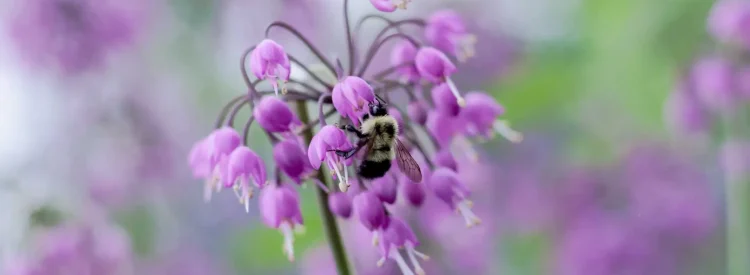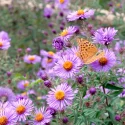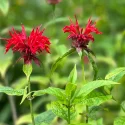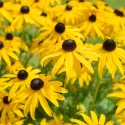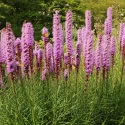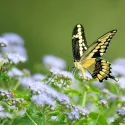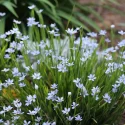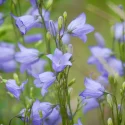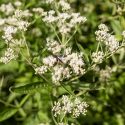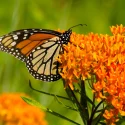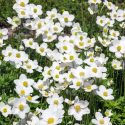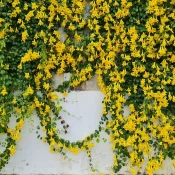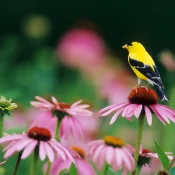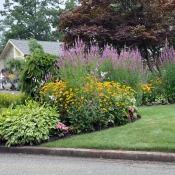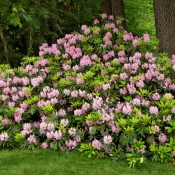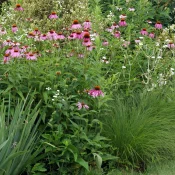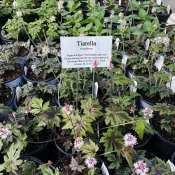Nodding Onions are lovely native flowers with small purple pom-pom flowers that bloom in the middle of the summer. When in bloom, they look like miniature fireworks. They are also deer-resistant, drought-tolerant, and easy to grow from seed. Because they are short (1-2 feet tall), Nodding Onions are perfect for borders and edges of sunny pollinator gardens. Find tips and planting inspiration below.
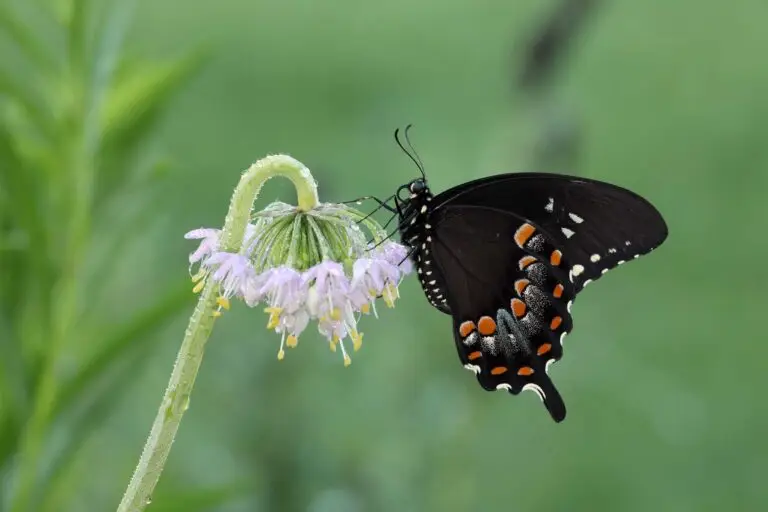
This plant goes by the common name Nodding Onion (Allium cernuum), which is a lovely way to describe the way its flowers hang down gracefully in the summer. They are easy to plant and because they are perennials, will come back year after year after they’re planted once. In this article, we will explore the benefits of planting Nodding Onion, discuss the challenges you may encounter, and provide helpful tips for successfully cultivating this charming perennial.
Let’s start with their name. You may be wondering:
Why is it called Nodding Onion?
Nodding Onion is this plant’s common name. A common name is a name given to a plant by previous generations. As we’ve discussed in our quick overview of Latin plant naming, many native plants have several common names, but they only have one Latin name.
This plant’s common name—Nodding Onion—refers to the way its blooms hang down in a graceful droop (you can almost imagine the bloom ‘nodding’ off to sleep) alongside the plant’s family tree.
Yes, you can eat Nodding Onion
While all parts of the Nodding Onion are technically edible, they are so bitter that they are not often eaten. This plant’s bitter taste also makes it deer-resistant.
Just like kitchen onions, Nodding Onions’ roots are bulbs. Dig them up and you’ll find a miniature onion-like round bulb beneath. This bulb root is also shared by other wild onions, including Wild Garlic. If you snap a piece of Nodding Onion stalk, you will smell the onion-y smell (it’s also why it’s sometimes called ‘Wild Onion.’)
If you’re looking to plant delicious natives, we highly recommend Pawpaw trees, Cranberry Viburnums, Hackberries, Serviceberries, and Blueberries.
What are the benefits of Nodding Onion?
There are so many benefits to planting Nodding Onion. Nodding Onion is:
- Deer resistant
- A pollinator favorite
- Drought-tolerant
- Easy to grow in a variety of soils
- Thrives in sun to part sun
Nodding Onion is also a native plant
Nodding Onion has grown in North America for thousands of years, making them a plant native to North America.
Native plants are excellent choices to grow for many reasons, including:
- Wildlife support. Native plants give bugs, pollinators, and birds the homes and food they need to survive.
- Fuss-free gardening. Native plants require minimal work, water, and care to thrive (especially compared to lawns.) After being established, Nodding Onions thrive with rain.
- Years of beauty. Native plants are GORGEOUS, and perennials like Nodding Onion come back year after year. They have been hiding in plain sight, and their beauty is undeniable. Explore our library to find your faves.
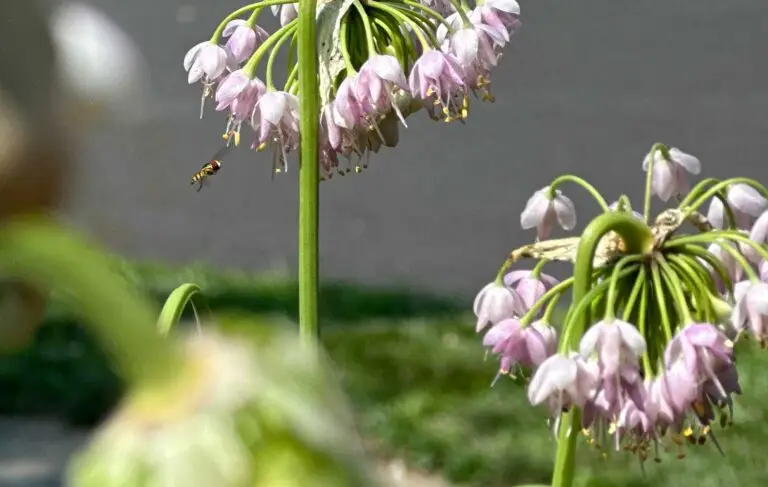
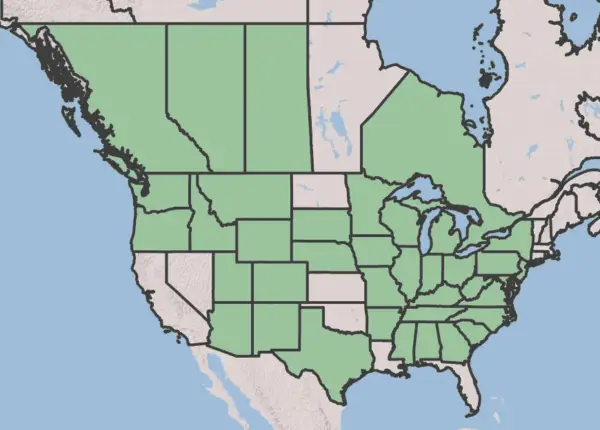
Where is Nodding Onion native?
Nodding Onion is native to most of the United States and Canada. Nodding Onion will happily thrive in any of the states in green. Map from the USDA’s Plants Database.
Where to plant Nodding Onion
Nodding Onions are shorter plants (12-16 inches). Because they are smaller plants, Nodding Onions look best when planted in groups of three or more. (Planting smaller plants in larger groups helps make a large impact in your garden.)
Nodding Onions are short—1-2 feet—so ensure larger plants do not block them. Their shortness makes them look great in borders and containers.
What if you plant Nodding Onion in the wrong spot?
If you make a mistake and plant them in a not-great spot—don’t worry! Simply dig them up (roots and all) and move them to a better location in the spring or fall. It’s so easy to recover from gardening mistakes when you plant native.
When does Nodding Onion bloom?
Nodding Onions bloom in the mid-summer. You’ll see them in bloom alongside Butterfly Weed, Rattlesnake Master, Coreopsis (Tickseed), and Bee Balm.
Nodding Onion is deer-proof
Deer do NOT eat Nodding Onion. If you’re worried about deer nibbling your garden, planting Nodding Onion is a good native gardening choice.
How to plant Nodding Onion
Nodding Onion is perfect for beginner gardeners, since it thrives in a wide range of light and soil.
Light
As mentioned earlier: Nodding Onion thrives in a wide range of light conditions, from full sun to part sun. The only spot that won’t work well is full shade.
Soil
Nodding Onion is just as resilient with sun as it is with soil. According to Everwilde Farms, “This plant adapts well to almost any soil and can survive in shade, clay, or rocky soil.” Again, if you feel you plant it in a not-great area, simply dig it up (roots and all) in the spring and fall and move it to a better spot.
Ninety % Native has a great overview video showing it in her hummingbird garden:
Plant Nodding Onion by seed
It is so easy to plant Nodding Onion by seed. You can plant them directly into the garden or in pots in the spring, as long as the seeds have been cold stratified.
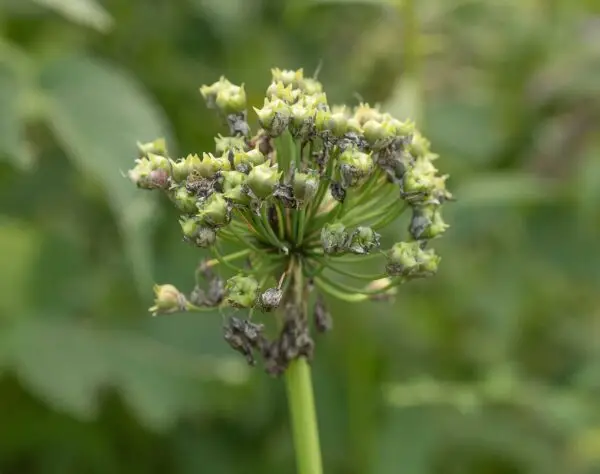
Nodding Onion seeds need ‘winter’ to grow
Some seeds won’t sprout until they’ve experienced a period of cold (e.g., winter). This period of cold dormancy is called cold stratification. Nodding Onion seeds need 60 days of cold before they will start to grow.
If you grab some seeds from a friend’s garden in the fall, store them in the fridge, unheated garage, or basement. You can also plant the seeds in the fall and let winter do the work for you.
What about if you buy Nodding Onion seeds?
If you’re buying Nodding Onion seeds, most seed sellers put their seeds in the cold before selling them—especially when you buy seeds in the spring. If you’re wondering if the seeds you’re buying have been cold-stratified (or not), just email the seed-selling website and ask.
There are lots of online seed sellers that offer Nodding Onion seeds. Some places to buy seeds include:
- Everwilde Farms (California)
- Prairie Moon Nursery (Minnesota)
- Wild Seed Project (Maine)
Why are we including the state alongside the seed seller? This is why:
Plants and seeds grown close to home are tuned to your soil, weather, and pollinators. Stay within 500 miles—or about a day’s drive—to help your garden thrive naturally.
Plant Nodding Onion from plants
Sadly, as of this article: no big-box nurseries have carried this plant. Fingers crossed that more large-scale plant places will start stocking more native plants in the coming years.
Here are four sourcing ideas to find Nodding Onion:
Where can I find seeds and plants?
Finding native plants can be challenging (we partly blame Marie Antoinette.) To make it easier, we’ve assembled four sourcing ideas.
300+ native nurseries make finding one a breeze
Explore 100+ native-friendly eCommerce sites
Every state and province has a native plant society; find yours
Online Communities
Local Facebook groups are a great plant source
What are good pairings for Nodding Onion?
Plant other pollinator favorites (as mentioned above) alongside flowers that bloom at other times to give pollinators food throughout the growing season. Late-blooming flowers include Asters, Black-Eyed Susans, Joe Pye Weed, and earlier-blooming flowers include Bee Balm and Blue-Eyed Grass.
Nodding Onion is a super to easy to grow addition to our native gardens. It’s graceful hanging flowers make it a favorite of pollinators—especially smaller bees, who can snuggle up to its pollen without fear of predators. It happily thrives in a variety of soils and withstands drought after its first year of planting. Nodding Onion is a beautiful addition to any Mid-Atlantic, Midwest, Northeast, or Southern garden. Happy native planting!
Sources
- Johnson, Lorraine and Colla, Sheila. A Northern Gardener’s Guide to Native Plants and Pollinators. (2023), 91.
- USDA Plant Database, Nodding Onion
- Loewer, Peter. Better Homes and Gardens: Step-by-Step Wildflowers & Native Plants. (1995), 97.
- University of Wisconsin-Madison Division of Extension. “Nodding Onion (Allium cernuum).” Wisconsin Horticulture. https://hort.extension.wisc.edu/articles/nodding-onion-allium-cernuum/.
What if your feed was actually good for your mental health?
Give your algorithm a breath of fresh air and follow us.
